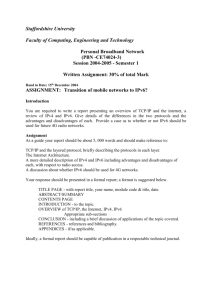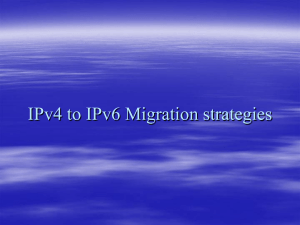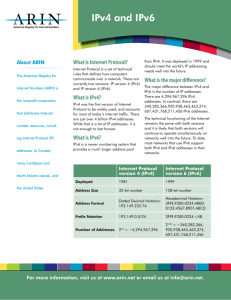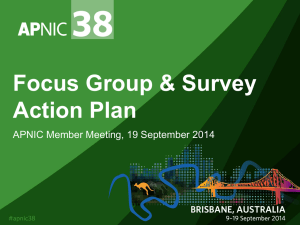ppt - Apnic
advertisement
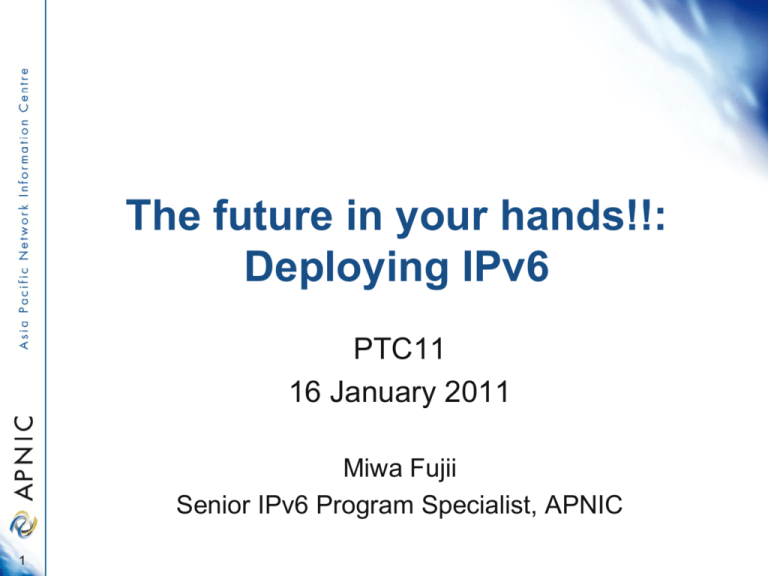
The future in your hands!!: Deploying IPv6 PTC11 16 January 2011 Miwa Fujii Senior IPv6 Program Specialist, APNIC 1 Overview • Introduction • Recap IP address • The RIRs and their communities • APNIC and its Policy Development Process • Where are we now? • Status of IPv4 address exhaustion • IPv6 deployment status • Message for Mobile Operators • Impact of IPv4 address exhaustion • Way forward • General recommendations for IPv6 deployment 2 What is an IP address? • The Internet Protocol • Packets, addressing and routing • IPv4 (192.168.0.0) • IPv6 (2001:0DB8::/32) • An IP address is a number • Every device directly connected to the Internet needs a unique IP address • IP address space is finite • Not the same as a Domain Name ! 3 On the Internet, you are nothing but an IP address! www.afrinic.net 196.216.2.1 www.nro.net 193.0.0.131 www.aptsec.org 116.68.148.101 www.apnic.net 202.12.29.20 202.12.29.142 www.isoc.org 206.131.253.68 www.lacnic.net 200.160.2.15 www.ripe.net 192.0.0.214 4 www.arin.net 192.149.252.7 IP Addresses: IPv4 vs. IPv6 5 IPv4 IPv6 Deployed 1981 Deployed 1999 32-bit address 192.149.252.76 128-bit address Address space 232 = ~4,000,000,000 Address space 2128 = ~340,000,000, 000,000,000,000,000, 000,000,000,000,000 Security, autoconfig, QoS, mobility added later (IPSec etc) Security, autoconfig, QoS “built-in” (IPSec etc) Projected lifetime: 2011 Projected lifetime: Indefinite 2001:DB8:0234:AB00:0123:4567:8901:ABCD How are IP addresses managed? • Regional Internet address Registries (RIRs) • • • • 6 Open membership-based industry bodies Non-profit, neutral, and independent Allocation, registration and other services APNIC: training, infrastructure, cooperation Regional Internet Registries • First established in early 1990s • Voluntarily by consensus of community • To ensure responsible and equitable address management, according to technical and administrative needs • To support Internet development • Consensus-based, open, and transparent participatory process 7 Regional Internet Registries The Internet community established the RIRs to provide fair and consistent resource distribution and accurate resource registration throughout the world. 8 APNIC’s Mission • Assist the Asia Pacific community in effective resource management • Equitable allocation and registration services • Membership total: around 2,400 • Provide educational opportunities • Fully equipped Training lab (IPv6 supported) • Coordinate IP addressing policy development and public positions • Seek public consideration of issues that benefit Members and the community 9 Policy Development Process Need Anyone can participate OPEN Evaluate ‘BOTTOM UP’ Implement Internet community proposes and approves policy Discuss TRANSPARENT Consensus All decisions & policies are documented & available Open Policy Meeting • APNIC holds two meetings per year • As a stand alone four-day meeting • As a conference track within APRICOT (Asia Pacific Regional Internet Conference on Operational Technologies) • Meetings include: • • • • 11 Special Interest Groups (SIGs) Birds of Feather sessions (BOFs) Training and education APNIC Member Meeting APRICOT-APAN 2011 12 APRICOT-APAN 2011 Many useful technical workshop and tutorial Including an IPv6 workshop and a conference 15 – 19 Feb 2011, 21-25 Feb 2011 13 Next APNIC meeting APNIC31 14 Next APNIC meeting APNIC31 Participation is open to anyone in the Internet community. Join us! 15 Status of IPv4 address exhaustion 16 Recap • Size of IPv4 addresses • 32-bit address • 232 = about 4.2 billion IP addresses • Unit to describe a size of IP address space • • • • / = slash notation /8 = 224 = about 16.5 million IPv4 addresses /16 = 216 = about 65,000 IPv4 addresses /24 = 28 = 256 IPv4 addresses • Allocation and assignment 17 IPv4 Address Global Distribution Available unallocated Pool at IANA 7 AfriNIC 3 35 256 x /8 34 18 3 December 2010 IPv4 Consumption: Projection Projected IANA exhaustion: Projected RIR exhaustion: 14/02/2011 31/10/2011 Nov 2011 19 http://www.potaroo.net/tools/ipv4/index.html 12/01/2011 IPv4 exhaustion planning Appropriate policies/procedures applied at different stage 20 Where are we now? IPv6 Deployment Statistics http://www.potaroo.net/ January 2011 21 What’s the question? Candidate questions: • How much of the public Internet supports IPv6? • How much of the public Internet runs IPv6? • How quickly is the Internet becoming end-to-end IPv6 capable? • How long will the dual stack transition take? 22 IPv6 BGP Table Size 4500 4000 3500 3000 2500 2000 1500 1000 500 0 2004 23 05 06 07 08 09 2010 11 IPv4 BGP Table Size 350,000 300,000 250,000 200,000 150,000 100,000 2004 24 05 06 07 08 09 2010 11 IPv6 / IPv4 BGP Table Size Ratio % 1.3 1.2 1.1 1.0 0.9 0.8 0.7 0.6 0.5 0.4 0.3 2004 25 05 06 07 08 09 2010 11 IPv6 / IPv4 BGP Table Size Ratio % 1.3 1.2 1.1• Is this a good indicator of IPv6 deployment? • Probably not. 1.0 0.9• The data sets are not directly comparable: • Historical fragmentation in IPv4 0.8 • Traffic engineering in IPv4 0.7 • Address aggregation in IPv6 0.6 • Use of tunneling prefixes in IPv6 0.5 0.4 0.3 2004 26 05 06 07 08 09 2010 11 IPv6 / IPv4 AS Count Ratio % 9 8 7 6 5 4 3 2 2004 27 05 06 07 08 09 2010 11 IPv6 Traffic “Google has quietly turned on IPv6 support for its YouTube video streaming Web site, sending a spike of IPv6 traffic across the Internet…” – 1 Feb 2010 Networld • Monash University, Melbourne, Australia: IPv6 Deployment Edges 29 Comcast http://www.comcast6.net/ 30 Comcast http://www.comcast6.net/ May 2010 • First native dual-stack customer activated • Comcast Business Class services June 2010 • Activated their first residential 6RD trial customer located in Cambridge, MA, USA 31 D-NET http://www.dnet.net.id/ 32 D-NET http://www.dnet.net.id/ 2006 • Implemented IPv6 based on the business decision made by Board of Director • Future proof to cope with IPv4 address exhaustion and to maintain sustainable growth 33 Google http://ipv6.google.com/ 2402:6800:8004::68 Facebook http://www.v6.facebook.com/ Experimental, non-production 2620:0:1cfe:face:b00c::3 iOS 4 2001:dc0:a000:6:62fb:42ff:fe44:69e7 Mobile networks • “Smartphones are driving a very large amount of network signaling…IPv6 is a priority” (T-Mobile) • “(IPv6 enabled) Handsets will become prolific in 2011” (Verizon) 37 IPv6 for Mobile Operators Are you ready with IPv4 address exhaustion? 38 Recap • Mobile Network Operators (MNOs) serve the largest number of users of connected devices • Over 4.6B GSM subscriptions • Smartphone: Prices decreasing • Wider and rapid penetration of smartphones that can be an Internet host – always on • MNOs must tackle IPv6 implementation 39 http://www.circleid.com/posts/ipv6_for_mobile_networks_time_to_act_now/, 25/10/2010 Transition mechanisms • • • • • • • • 40 Dual stack native DS-lite 6in4 6to4 6RD IVI NAT64 Etc. But it is more than technical… • IPv6 transition is more than selecting a transition method: • Requires enterprise-wide effort • Touches many parts of a MNOs’ network, processes, tools, people etc. • Running complicated IPv4 networks with multiple NATs and renumbering to cope with IPv4 address exhaustion • Possible factor of cost differential of IPv4 and IPv6 services 41 http://www.circleid.com/posts/ipv6_for_mobile_networks_time_to_act_now/, 25/10/2010 T-Mobile • T-Mobile IPv6 Friendly User Trial 42 http://forums.t-mobile.com/t5/Nokia/T-Mobile-IPv6-Friendly-User-Trial/m-p/465928 Verizon • Verizon begins testing IPv6 on FiOS services 43 http://newscenter.verizon.com/press-releases/verizon/2010/verizon-begins-testing-ipv6.html General recommendations for IPv6 deployment Wayforward 44 Preparing for IPv6 Transition Overall planning 1. Review the impact of IPv4 address exhaustion • Inventory of your IT assets 2. Develop an IPv6 deployment plan • Strategy, scope of the deployment, schedule, auditing of execution of the plan • How to manage coexistence of IPv4 and IPv6 • Where to start to deploying IPv6? • What transition techniques to be employed? • Staff training 3. Budget readiness Preparing for IPv6 transition • Technical management • Assess the possibility of IPv4 and IPv6 coexistence with desired technology • There are quite a few transition technologies are available • Assess security implication of IPv6 • Any new technology comes with new security threats and vulnerabilities • Human capacity development • Develop a plan to acquire skills to implement IPv6 • Implement a test networks with IPv6 46 IPv6: A prerequisite to the sustainable long-term development of a ubiquitous and open Internet Thank you! <miwa@apnic.net> 47
